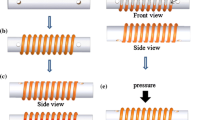Abstract
The influence of surface cleanliness of Au/Ni coated multichip materials (MCMs), Ag plated Cu lead frames, and Al bond pads on semiconductor chips on the strength of Au wire bond contacts has been investigated. A clean surface is important for good adhesion in any kind of attachment process. Investigations by means of x-ray photoelectron spectroscopy have been performed on the bond substrates to determine the chemical composition, the nature as well as the thickness of the contamination layer. The influence of contamination on bond contact quality has been examined by pull force measurements, which is an established test method in semiconductor packaging industry for evaluating the quality of wire bonds. The results clearly show that a strong correlation between the degree of contamination of the substrate and pull strength values exists. Furthermore, a contamination thickness limiting value of 4 nm for Au and Ag substrates was determined, indicating good wire bond contact quality. The effect of plasma cleaning on wire bondability of metallic and organic (MCMs) substrates has been examined by pull force measurements. These results confirm the correlation between surface contamination and the strength of wire bond contacts for Au/Ni coated MCMs and Ag plated Cu lead frames. Atomic force microscopy measurements have been performed to determine the roughness of bond surfaces, demonstrating the importance of nanoscale characterization with regard to the bonding behavior of the substrates. Finally, bonding substrates used in integrated circuit packaging are discussed with regard to their Au wire bonding behavior. The Au wire bonding process first results in a cleaning effect of the substrate to be joined and secondly enables the change of bonding energy into frictional heat giving rise to an enhanced interdiffusion at the interface.
Similar content being viewed by others
References
Annual Handbook of ASTM Standards, F 1269, Test Methods for Destructive Shear Testing of Ball Bonds (Philadelphia, ASTM, 1990).
Military Standard, MIL-STD83C, Test Methods and Procedures for Microelectronics Methods 2010/2011/2023 (1989).
F. Rudolf, K.D. Lang, G. Jarney, Prüfverfahren für Drahtbondverbindungen, Teil I: Mechanische Prüfung. Teil II: Visuelle, elektrische und sonstige Verfahren, VTE 7 (1995).
G.G. Harman, Reliability and Yield Problems of Wire Bonding in Microelectronics: The Application of Materials and Science, (National Institute of Standards and Technology, 1994).
G.G. Harman, The Application of Materials and Interface Science, New York (1991).
J.F. Graves, The Intl. J. on Hybrid Microelectronics 6, 147 (1983).
K.H. Ernst, D. Grman and R. Hauert, Surf. and Interface Analysis 21, 691 (1994).
D. Grman, R. Hauert, E. Hollander and M. Amstutz, Solid State Technol. 35, 43 (1992).
N. Onda et al., DC-Hydrogen Plasma Cleaning in IC Packaging, Proc. of SEMICON Singapore (1996).
E. Wandke, Plasmaunterstützte Prozesse in der Elektronik, Transfer, Nr. 40 (1996).
J.J. Yeh and I. Landau, At. Data Nucl. Data Tables 32, 7 (1985).
N. Korner et al., Surf. and Coatings Techn. 76–77, 731 (1995).
J. Falk, J. Hauke and G. Kyska, Wire bonding on PCBs, Circuit World 20, 8 (1994).
R.F. Roberts, D.L. Allara, C.A. Pryde, D.N.E. Buchanan and N.D. Hobbins, Surf. Interface Anal. 2, 5 (1980).
M.P. Seah and W.A. Dench, Surf. Inter. Anal. 1 (1979).
G. Beamson and D. Briggs, High Resolution XPS of Organic Polymers, (London: John Wiley & Sons, 1992).
C.D. Wagner, W.M. Riggs, L.E. Davis and J.F. Moulder, Handbook of XPS, (Perkin-Elmer, 1978).
C.T. Campell and M.T. Paffett, Surf. Sci. 143, 517 (1984).
C.T. Campell, Surf. Sci. 157, 43 (1985).
J.H. Linn and W.E. Swartz, Spectrosc. Lett. 18, 335 (1985).
J.F. Graves and W. Gurany, Solid State Technol. 26, 227 (1993).
J. Goodman and S. Andrews, Solid State Technol. 33, 65 (1990).
J.H. Thomas, C.E. Bryson and T.R. Pampalone, Surf. Inter. Anal. 14, 39 (1989).
J.F. Graves and W. Gurany, Solid State Technol. 26, 227 (1993).
R. Hauert, Thin Solid Films 206, 323 (1991).
M. Textor and R. Grauer, Corr. Sci. 23, 41 (1983).
B.B. Mandelbrot, The Fractal Geometry of Nature, (New York: Freeman, 1982).
G. Dietler and Y. Zhang, Phys. A 191, 213 (1992).
A. Stalder, Ph.D. thesis, University of Fribourg, Switzerland (1995).
G. Zambelli and L. Vincent, Materials and Contacts: A Tribological Approach, (Presses Polytechniques et Universitaires Romandes, 1998).
Author information
Authors and Affiliations
Rights and permissions
About this article
Cite this article
Schneuwly, A., Gröning, P., Schlapbach, L. et al. Influence of surface contamination on metal/metal bond contact quality. J. Electron. Mater. 27, 990–997 (1998). https://doi.org/10.1007/s11664-998-0132-1
Received:
Accepted:
Issue Date:
DOI: https://doi.org/10.1007/s11664-998-0132-1




